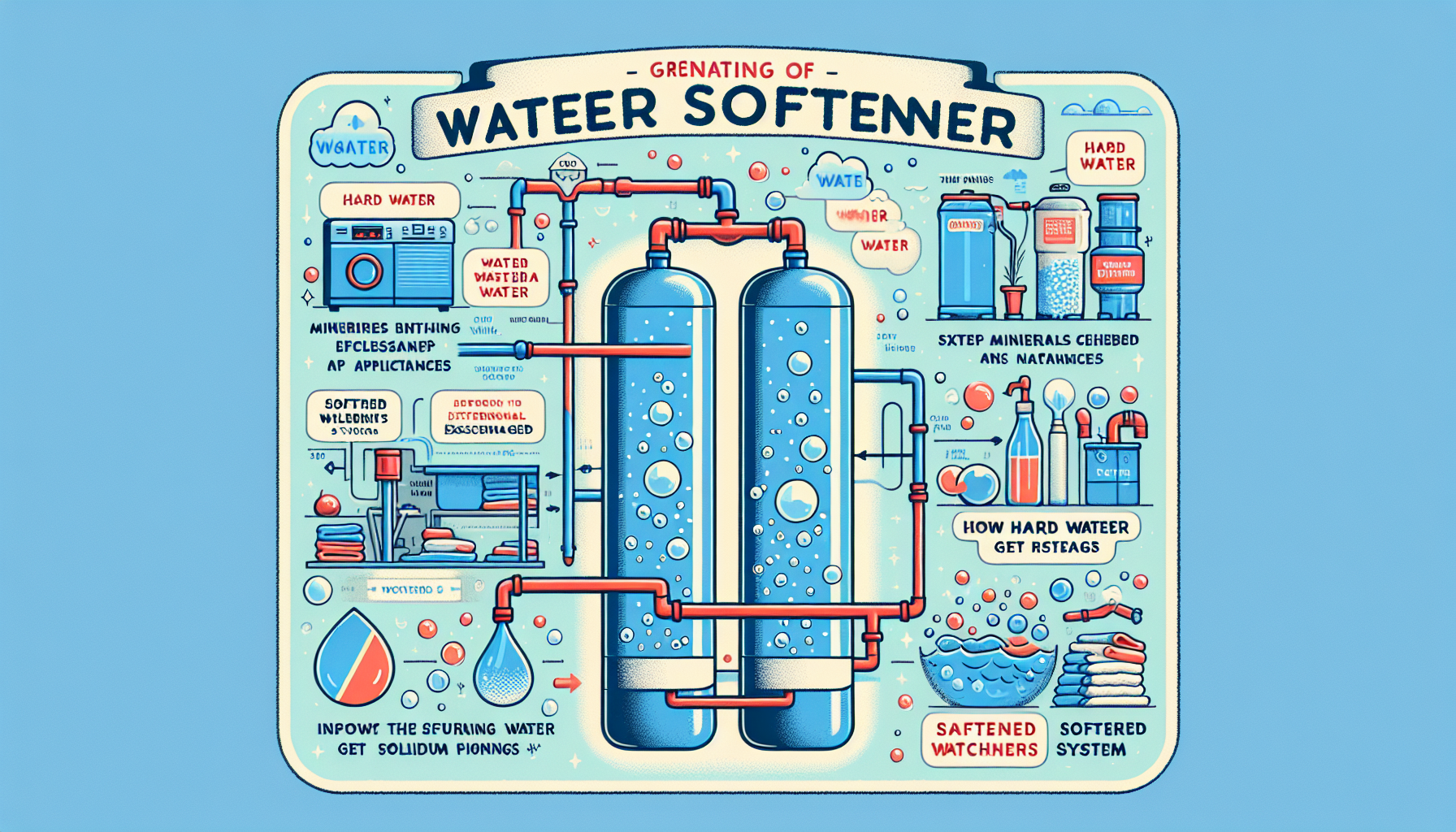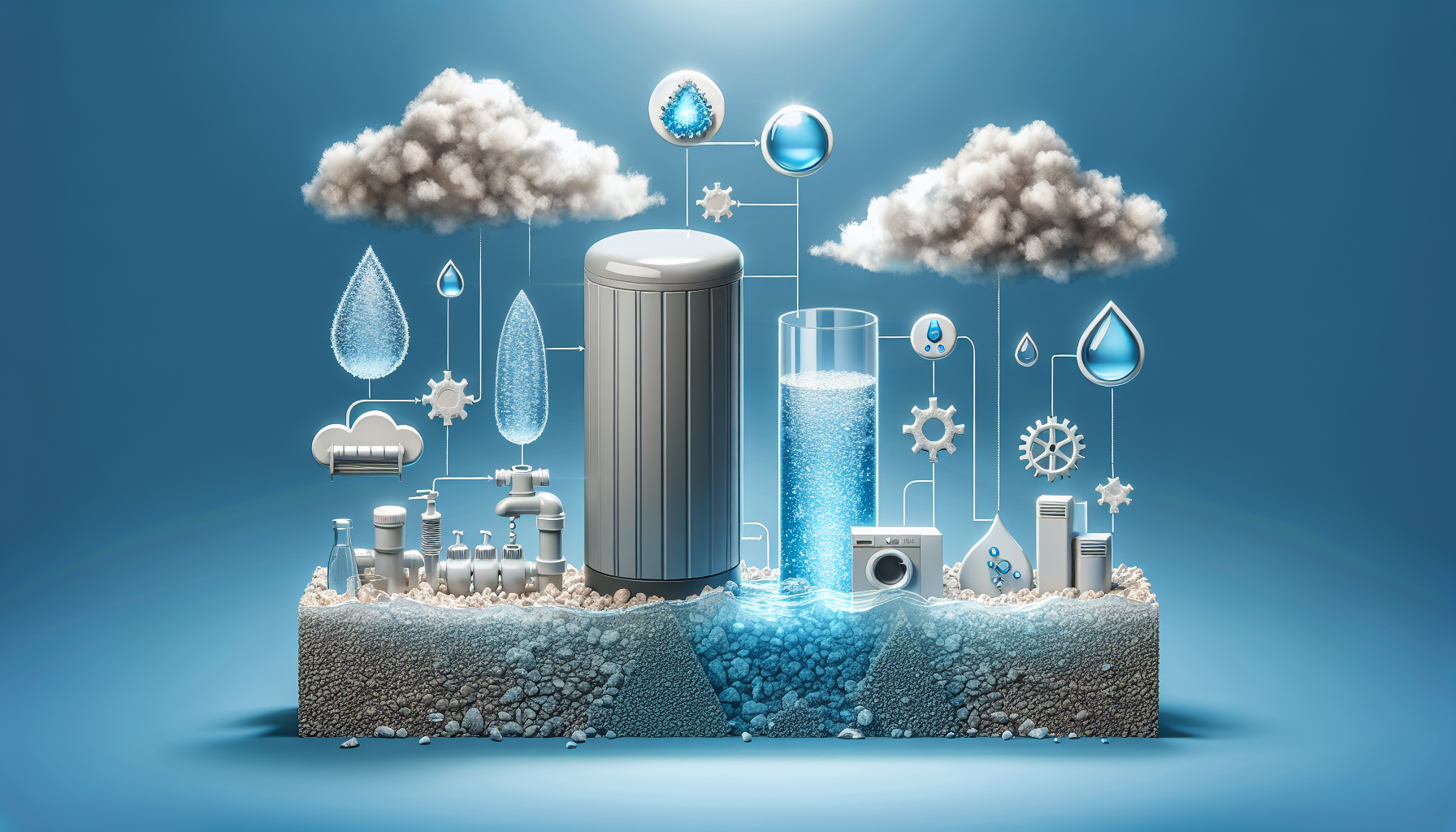Water softeners play a crucial role in ensuring that you have high-quality water in your home. In this article, you will gain a comprehensive understanding of the basics of water softeners, from how they work to their benefits. Whether you are a homeowner looking to invest in a water softener or simply curious about how they operate, this article will provide you with all the necessary information you need to know. Say goodbye to pesky limescale buildup and say hello to smoother skin and more efficient appliances as we delve into the world of water softeners.
What is Hard Water?
Hard water is water that contains a high concentration of minerals, particularly calcium and magnesium. These minerals are naturally present in the ground and can dissolve into the water as it passes through rocks and soil. When these minerals are present in high quantities, the water is considered hard.
Effects of Hard Water
On Skin and Hair
Hard water can have a negative impact on your skin and hair. The minerals in the water can leave behind a residue on your skin, making it feel dry and itchy. It can also cause dandruff and make your hair feel rough and dull. Additionally, hard water can strip away the natural oils from your hair, leading to increased frizz and breakage.
On Household Appliances
Hard water can be damaging to household appliances as well. The minerals in the water can build up inside pipes and faucets, causing blockages and reducing water flow. This mineral buildup can also affect the efficiency of dishwashers, washing machines, and water heaters, leading to increased energy consumption and potential breakdowns.

What are Water Softeners?
Water softeners are devices that are designed to remove the minerals that cause water hardness. They work by using a process called ion exchange, which replaces the calcium and magnesium ions with sodium or potassium ions. This process effectively “softens” the water, making it less harsh on your skin, hair, and household appliances.
How Water Softeners Work
Water softeners typically consist of two main components: a mineral tank and a brine tank. The mineral tank contains resin beads that are coated with sodium ions. As hard water passes through the mineral tank, the calcium and magnesium ions in the water are exchanged with the sodium ions on the resin beads, effectively removing the minerals from the water.
Once the resin beads have become saturated with calcium and magnesium ions, the water softener enters a regeneration cycle. During this cycle, a brine solution is flushed through the mineral tank, which causes the sodium ions to be released from the resin beads and replace the calcium and magnesium ions. The excess minerals and brine solution are then flushed out of the system, leaving the resin beads ready to soften water again.

Types of Water Softeners
Salt-Based Water Softeners
Salt-based water softeners are the most common type of water softeners. As the name suggests, these systems use salt, typically in the form of large salt pellets, to regenerate the resin beads in the mineral tank. The brine solution used to regenerate the resin beads is created by dissolving these salt pellets. Salt-based water softeners are highly effective in removing minerals from water but require regular maintenance, including adding salt to the brine tank.
Salt-Free Water Softeners
Salt-free water softeners, also known as water conditioners, are an alternative to salt-based systems. Instead of using ion exchange to remove minerals, these systems use a different technology called Template Assisted Crystallization (TAC). TAC systems alter the structure of the minerals in the water, preventing them from adhering to surfaces and causing scaling. Salt-free water softeners are low maintenance and do not require the use of salt or electricity, but they may not be as effective in extreme hard water conditions.
Dual-Tank Water Softeners
Dual-tank water softeners are a more advanced type of water softener. They feature two mineral tanks, allowing one tank to be in the regeneration cycle while the other is in operation, ensuring a continuous supply of softened water. This type of system is ideal for households with higher water usage or for commercial applications where a constant supply of soft water is essential.
Choosing the Right Water Softener
When choosing a water softener for your home, there are several factors to consider:
Water Hardness Level
The hardness level of your water will determine the capacity and efficiency of the water softener you need. If you have extremely hard water, you may require a higher capacity system.
Water Usage
The amount of water your household consumes daily will also impact the size and capacity of the water softener you need. Larger households with higher water usage will require a larger system to ensure a continuous supply of soft water.
Budget
Water softeners can vary greatly in price, so it’s important to consider your budget when making a decision. While salt-based systems are generally more affordable upfront, they require ongoing maintenance and the purchase of salt, which adds to the cost over time.
Maintenance Requirements
Consider the level of maintenance you’re willing to undertake. Salt-based systems require regular maintenance, including adding salt to the brine tank, whereas salt-free systems have minimal maintenance requirements.
Installing a Water Softener
It is recommended to have a professional plumber install a water softener to ensure it is properly connected to your home’s plumbing system. They will determine the best location for the softener and connect it to the main water supply. The installation process typically involves connecting the mineral tank, brine tank, and control valve to the plumbing system. Additionally, a bypass valve may be installed to allow you to bypass the softener when necessary.
Operating and Maintaining Water Softeners
Proper operation and maintenance of your water softener are crucial for its effectiveness and longevity. Here are a few key maintenance tasks to keep in mind:
Salt-Bed Maintenance
If you have a salt-based water softener, regularly check the salt level in the brine tank and add more salt as needed. It’s important to maintain an adequate salt level to ensure the resin beads can be properly regenerated.
Cleaning and Regeneration
Regularly clean the mineral tank to remove any sediment or debris that may accumulate over time. Additionally, make sure to follow the manufacturer’s instructions for regenerating the resin beads to keep the system functioning properly.
System Inspections
Periodically inspect the water softener system for any leaks, blockages, or signs of malfunction. Check the control valve, connections, and pipes for any issues and address them promptly.
Replacing Components
Over time, certain components of the water softener may wear out and need replacement. This could include the resin beads, control valve, or seals. It’s important to follow the manufacturer’s guidelines for replacing these components to ensure proper functioning of the system.
Alternative Water Treatment Options
In addition to water softeners, there are other water treatment options available:
Water Conditioners
Water conditioners, also known as salt-free water softeners, use a different technology to alter the structure of minerals in the water, preventing scaling. While they may not remove all minerals from the water like traditional water softeners, they can help reduce the negative effects of hard water without the use of salt.
Reverse Osmosis Systems
Reverse osmosis systems are highly effective at removing minerals, contaminants, and impurities from water. They use a semipermeable membrane to filter out particles, leaving you with clean and softened water. Reverse osmosis systems are typically installed under the sink and can provide a separate faucet for drinking water.
Common Issues and Troubleshooting
Here are some common issues you may encounter with your water softener and possible solutions:
Low Water Pressure
If you notice a decrease in water pressure, it could be due to a clogged screen or valve. Try cleaning or replacing these components to restore proper water flow.
Resin Beads Fouling
Resin beads can become fouled over time, reducing their effectiveness in removing minerals from the water. In such cases, the resin beads may need to be cleaned or replaced to restore the softening capability of the system.
Salt Bridges
Sometimes, a layer of hardened salt can form in the brine tank, creating what is known as a “salt bridge.” This prevents the salt from properly dissolving and can interfere with the regeneration process. Breaking up the salt bridge and removing the hardened salt can resolve this issue.
System Leaks
Leakages can occur in various parts of the water softener system, such as the control valve, connections, or pipes. Inspect the system for any signs of leaks and address them promptly to prevent further damage.
By understanding the basics of water softeners and considering the specific needs of your household, you can choose the right system and enjoy the benefits of softened water. Remember to follow proper maintenance procedures and address any issues that may arise to ensure the continued efficiency of your water softener. Soft, smooth skin, shiny hair, and well-protected appliances are just a few of the many advantages of having a water softener in your home.

